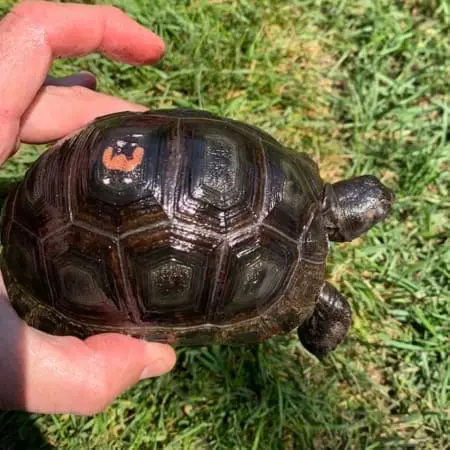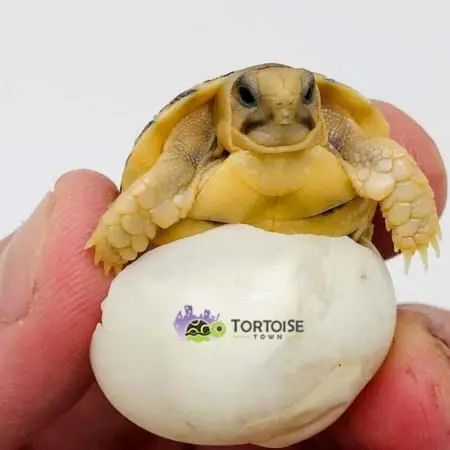Tortoise Diet & Nutrition From Hatchling to Adult: Sulcata, Russian, Leopard & More
A proper diet is the foundation of tortoise health at every life stage. From tiny hatchlings to full-grown adults, Sulcata, Russian, leopard, Greek, Hermann’s and red foot tortoises all rely on high-fiber, herbivorous nutrition to support strong shells, bones and organs. Poor diets lead to pyramiding, organ damage and chronic health problems, while well-designed diets help tortoises thrive for decades.
This guide walks through diet and nutrition from hatchling to adult, with species-specific notes for grassland and forest tortoises.
Tortoise for sale near me because they start their babies on proper grazing diets, making it easy for you to continue the same routines at home.

Hatchling Diet Basics
Hatchling tortoises are small but grow quickly. Their diets should focus on finely chopped, high-fiber greens and weeds appropriate for their species.
- Offer small amounts of food daily so nothing spoils.
- Use safe weeds and greens like dandelion, plantain, clover (in moderation), endive and escarole.
- Provide shallow water dishes and frequent warm soaks for hydration.
Forest species like red foot tortoises may receive tiny amounts of fruit once they are eating well, while grassland species like Sulcata and leopard tortoises typically avoid fruit entirely.
Juvenile Diet & Growth
As tortoises grow into juveniles, their appetites expand and they can handle more variety. At this stage, you can incorporate more grasses and hay, especially for grassland species.
- Sulcata & Leopard: Increase grasses and hay as shell size increases.
- Russian, Greek & Hermann’s: Continue weeds and greens, with some grass introduction.
- Red Foot: Maintain a mixed diet of greens, weeds and occasional fruit in moderation.
Monitor growth by weight and appearance. Smooth, steady growth is ideal. Rapid, excessive weight gain or bumpy shell development suggests dietary or husbandry problems.
Adult Tortoise Diet
Adult tortoises still rely on high-fiber plant material but may eat larger quantities less frequently, especially if they have access to outdoor grazing.
Key diet components for adults:
- Grasses & hay: Critical for Sulcata and leopard tortoises; beneficial for others.
- Weeds: Dandelion, plantain, clover and other safe plants.
- Leafy greens: Endive, escarole, turnip greens, mustard greens and similar offerings.

Foods to Avoid
Some foods often offered by well-meaning owners are actually harmful to tortoises over time.
- High-protein animal foods like dog or cat food.
- Most fruits for grassland species (limit or skip entirely).
- Processed human foods like bread, pasta and snacks.
- High-oxalate greens in large quantities (spinach, beet greens, etc.).
These items can disrupt digestion, strain the kidneys and contribute to shell and bone problems.
Calcium, UVB & Shell Health
Diet alone cannot guarantee proper shell and bone health. Tortoises must have access to both calcium and UVB radiation to synthesize vitamin D3 and use that calcium correctly.
- Offer plain calcium powder several times per week, especially for growing tortoises.
- Provide high-quality UVB lighting indoors or safe outdoor sunlight.
- Ensure balanced temperatures so digestion and metabolism work efficiently.
Hydration & Soaking
Hydration plays a major role in nutrition. Even if you offer the perfect foods, a dehydrated tortoise cannot process them efficiently.
- Keep shallow, clean water dishes available at all times.
- Soak hatchlings and juveniles frequently in warm, shallow water.
- Monitor adult tortoises for signs of dehydration, especially in hot, dry climates.
Species-Specific Diet Notes
- Sulcata & Leopard: Primarily graze on grasses and hay. If you plan to buy Sulcata tortoise or buy leopard tortoise, be ready to supply abundant, high-fiber plant material.
- Russian, Greek & Hermann’s: These Mediterranean tortoises thrive on weeds and leafy greens with some grass, avoiding fruit and animal protein.
- Red Foot: Include more leafy greens and safe weeds, plus occasional fruit, while maintaining proper humidity and warmth.
Where to Start With a Well-Fed Tortoise
The easiest way to implement a strong diet is to start with a tortoise that has already been eating properly. Many beginners begin by searching for a tortoise for sale and then learn how important it is to choose where to buy tortoise that has been raised on high-fiber, species-appropriate foods from the beginning.
When you purchase a well-started baby from a reputable tortoise farm, you simply continue the same diet at home, adjusting only for growth and local availability of weeds, grasses and greens. Over time, consistent, high-quality nutrition will show in smooth shells, bright eyes and active, curious behavior—from hatchling to adult.




